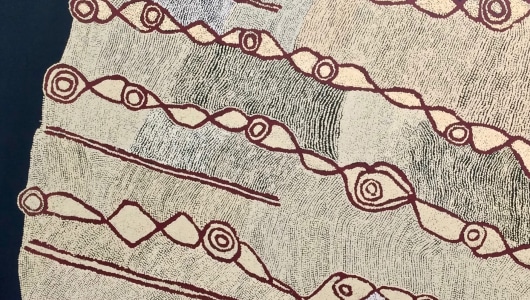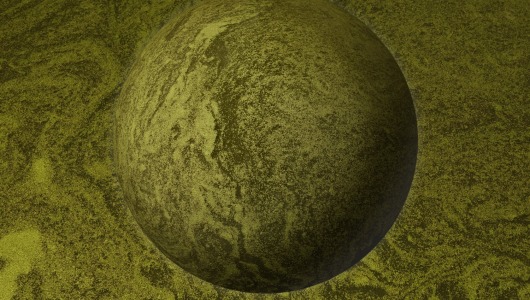Inloggen
Registreren
NL
Paddy Nyunkuny Bedford 1922 - 2007
Vertegenwoordigd door:
SmithDavidson Gallery
Paddy Nyunkuny Bedford werd geboren in Bedford Downs Station in East Kimberley, West-Australië. Hij behoorde tot het Gija-volk en zijn familiegeschiedenis werd gekenmerkt door brute conflicten tussen blanke kolonisten en zijn inheemse voorouders. Bedford werkte als veedrijver totdat een blessure hem daarvan weerhield. Als senior advocaat hield hij zich vanaf zijn vroege volwassenheid bezig met traditionele ceremoniële schilderkunst, maar begon pas in 1998 met schilderen op doek en later met gouache op papier.
Hij sloot zich aan bij de nieuw opgerichte Jirrawun Arts-groep en maakte deel uit van de East Kimberley/Turkey Creek-beweging. In acht jaar tijd bouwde Bedford een rijk oeuvre op en groeide hij uit tot één van Australië's belangrijkste inheemse kunstenaars. Zijn solotentoonstellingen in Melbourne, Sydney, Canberra en Darwin werden lovend ontvangen. Zijn stijl kenmerkt zich door gedurfde, grafische elementen, opvallende kleuren en spaarzame maar nauwkeurig geplaatste lijnen, vaak afgebakend door witte stippen. Zijn werken verbeelden het landschap van East Kimberley en Droomtijdverhalen die verband houden met zijn familie, evenals historische gebeurtenissen zoals het bloedbad van Bedford Downs. Centraal in zijn werk staat het thema verzoening, ook wel 'tweezijdig' genoemd.
Bezoek onze website smith-davidson.com voor meer informatie.
Hij sloot zich aan bij de nieuw opgerichte Jirrawun Arts-groep en maakte deel uit van de East Kimberley/Turkey Creek-beweging. In acht jaar tijd bouwde Bedford een rijk oeuvre op en groeide hij uit tot één van Australië's belangrijkste inheemse kunstenaars. Zijn solotentoonstellingen in Melbourne, Sydney, Canberra en Darwin werden lovend ontvangen. Zijn stijl kenmerkt zich door gedurfde, grafische elementen, opvallende kleuren en spaarzame maar nauwkeurig geplaatste lijnen, vaak afgebakend door witte stippen. Zijn werken verbeelden het landschap van East Kimberley en Droomtijdverhalen die verband houden met zijn familie, evenals historische gebeurtenissen zoals het bloedbad van Bedford Downs. Centraal in zijn werk staat het thema verzoening, ook wel 'tweezijdig' genoemd.
Bezoek onze website smith-davidson.com voor meer informatie.
Kunstwerken
Articles
Media
Highlights
Over de kunstenaar
In collectie van
Tentoonstellingen
Marktpositie
CV
Aangeboden kunstwerken van Paddy Nyunkuny Bedford
Media

Paddy Nyunkuny Bedford aan het schilderen
Tentoonstellingen
Marktpositie
Ondanks de late start van zijn artistieke carrière, bereikte Bedford buitengewoon succes. Bedford overschreed de beperkingen van 'Aboriginal kunst', opgelegd door kunstadviseurs en galerieën, door stereotypen te verwerpen en te experimenteren met een breder scala aan materialen en kleuren. Zijn werken zijn te vinden in belangrijke openbare en particuliere collecties wereldwijd, zoals in de National Gallery of Australia en in het Metropolitan Museum of Art (MoMA) in New York. Hij was één van de acht Australische inheemse kunstenaars die in 2006 de opdracht kregen een permanent werk te maken voor het Musée du Quai Branly in Parijs. Dat jaar werd hij geëerd met een grote overzichtstentoonstelling in het Museum of Contemporary Art in Sydney, die door het hele land toerde.
Na zijn dood in 2007 groeide zijn reputatie, toen Qantas een Boeing 737-800-livery bestelde die zijn werk Medicine Pocket (2005) weerspiegelde. Zijn werken werden geveild ter ondersteuning van zijn gemeenschap via de Paddy Bedford Education Trust. Beide werken die door SmithDavidson Gallery worden aangeboden, maakten deel uit van deze benefietveiling en waren tevens opgenomen in de retrospectieven van de kunstenaar in het Aboriginal Art Museum Utrecht (AAMU), Nederland.
Na zijn dood in 2007 groeide zijn reputatie, toen Qantas een Boeing 737-800-livery bestelde die zijn werk Medicine Pocket (2005) weerspiegelde. Zijn werken werden geveild ter ondersteuning van zijn gemeenschap via de Paddy Bedford Education Trust. Beide werken die door SmithDavidson Gallery worden aangeboden, maakten deel uit van deze benefietveiling en waren tevens opgenomen in de retrospectieven van de kunstenaar in het Aboriginal Art Museum Utrecht (AAMU), Nederland.
CV
Selected Collections:
Art Gallery of Western Australia, Perth, Australia
Museum and Art Gallery of the Northern Territory, Darwin, Australia
National Gallery of Australia, Canberra, Australia
National Gallery of Victoria, Melbourne, Australia
Art Gallery of New South Wales, Sydney, Australia
Lam Collection, University of San Antonio, Texas, USA
The Araluen Art Collection, Alice Springs, Australia
Museum of Contemporary Art (MCA), Sydney, Australia
The British Museum, London, United Kingdom
Metropolitan Museum of Art (MoMA), New York, USA
Private collections in Australia and internationally
Art Gallery of Western Australia, Perth, Australia
Museum and Art Gallery of the Northern Territory, Darwin, Australia
National Gallery of Australia, Canberra, Australia
National Gallery of Victoria, Melbourne, Australia
Art Gallery of New South Wales, Sydney, Australia
Lam Collection, University of San Antonio, Texas, USA
The Araluen Art Collection, Alice Springs, Australia
Museum of Contemporary Art (MCA), Sydney, Australia
The British Museum, London, United Kingdom
Metropolitan Museum of Art (MoMA), New York, USA
Private collections in Australia and internationally
Gratis Online Magazine
Artikelen, interviews, shows & events. Wekelijks bezorgd in uw mailbox.






